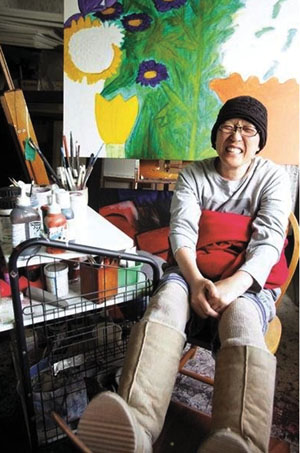
Death was only another source of aesthetic inspiration for Kim Jum-sun (’71,Educational Technology), a Western Painting artist and writer, who died on the morning of March 22 after a year-long suffering from ovarian cancer. “The gods must have coveted the free spirit as much as we did,” wrote a blogger named Buzzmetrician, underneath a picture of the late Kim’s unique works.
Kim was born in April 24, 1946 and was noted for her simple strokes and child-like pureness that was directly interpreted into her works. She drew with basic colors and lines using a computer mouse. In 2007, she was diagnosed with oval cancer but refused to stop drawing.
After she reached the last stages of chemotherapy, she agreed to publish a biography. “After I was diagnosed, I ate a lot and slept a lot. I actually felt healthier than I had before I got cancer,” Kim had told the press weeks before her death. “I had had surgery and was lying on my bed when these people from the publisher came and clamored me to write and illustrate a book. I said yes. I was bored.” Her biography, Kim Jum-dyun, was published two weeks before her death.
Kim wrote in her biography that the life of every individual is “the best and one of a kind piece of art,” just as she had come to believe herself making a suicide attempt with her friends during college. Just before the fatal move, the thought that she would never be able to look at another art piece again stopped her in her actions and convinced her to love and appreciate life as it was.
Her works mostly caught attention for the way nature were portrayed. She mostly enjoyed drawing running horses and flying ducks. Flowers and meadows were enlarged to fill up the entire canvas. Like her unbound nature, her pictures also reflected a yearning for pure freedom. Pictures of smiling horses and flying ducks were always signed off with a crooked “Jum-sun,” in childish letterings.
Kim’s personal record is just as topsy-turvy. She had entered Ewha not as an art major, but went on to study art at
In 1972, she inspired the public and fellow artists when her piece was selected by the late artist Baek Nam-joon, as a Korean candidate to be entered into Paris Biennale, a world renowned biannual international art contest. In 1987 and 1988, she went on to being named as the Best Artist of the Year two years in a row by the Korean Art Critic Association. She illustrated numerous major publications, including President Lee Myung-bak’s “Mother” and renowned
Park had entrusted Kim with the cover of her book, praising her for the unique pureness Kim blew into her drawings. “Kim succeeds in wading off any elements of fraud and hypocrisy, pinpointing the core of the object so that the zinnia elegans flower becomes more of a zinnia elegans flower, and the paeonia flower more of a paeonia flower than anything else.” Kim’s funeral was held on March 24.


